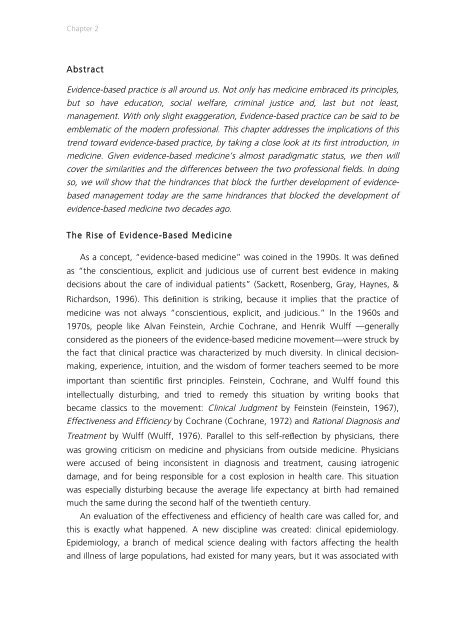In Search of Evidence
jqluvth
jqluvth
You also want an ePaper? Increase the reach of your titles
YUMPU automatically turns print PDFs into web optimized ePapers that Google loves.
Chapter 2<br />
Abstract<br />
<strong>Evidence</strong>-based practice is all around us. Not only has medicine embraced its principles,<br />
but so have education, social welfare, criminal justice and, last but not least,<br />
management. With only slight exaggeration, <strong>Evidence</strong>-based practice can be said to be<br />
emblematic <strong>of</strong> the modern pr<strong>of</strong>essional. This chapter addresses the implications <strong>of</strong> this<br />
trend toward evidence-based practice, by taking a close look at its first introduction, in<br />
medicine. Given evidence-based medicine’s almost paradigmatic status, we then will<br />
cover the similarities and the differences between the two pr<strong>of</strong>essional fields. <strong>In</strong> doing<br />
so, we will show that the hindrances that block the further development <strong>of</strong> evidencebased<br />
management today are the same hindrances that blocked the development <strong>of</strong><br />
evidence-based medicine two decades ago.<br />
The Rise <strong>of</strong> <strong>Evidence</strong>-Based Medicine<br />
As a concept, “evidence-based medicine” was coined in the 1990s. It was defined<br />
as “the conscientious, explicit and judicious use <strong>of</strong> current best evidence in making<br />
decisions about the care <strong>of</strong> individual patients” (Sackett, Rosenberg, Gray, Haynes, &<br />
Richardson, 1996). This definition is striking, because it implies that the practice <strong>of</strong><br />
medicine was not always “conscientious, explicit, and judicious.” <strong>In</strong> the 1960s and<br />
1970s, people like Alvan Feinstein, Archie Cochrane, and Henrik Wulff –generally<br />
considered as the pioneers <strong>of</strong> the evidence-based medicine movement–were struck by<br />
the fact that clinical practice was characterized by much diversity. <strong>In</strong> clinical decisionmaking,<br />
experience, intuition, and the wisdom <strong>of</strong> former teachers seemed to be more<br />
important than scientific first principles. Feinstein, Cochrane, and Wulff found this<br />
intellectually disturbing, and tried to remedy this situation by writing books that<br />
became classics to the movement: Clinical Judgment by Feinstein (Feinstein, 1967),<br />
Effectiveness and Efficiency by Cochrane (Cochrane, 1972) and Rational Diagnosis and<br />
Treatment by Wulff (Wulff, 1976). Parallel to this self-reflection by physicians, there<br />
was growing criticism on medicine and physicians from outside medicine. Physicians<br />
were accused <strong>of</strong> being inconsistent in diagnosis and treatment, causing iatrogenic<br />
damage, and for being responsible for a cost explosion in health care. This situation<br />
was especially disturbing because the average life expectancy at birth had remained<br />
much the same during the second half <strong>of</strong> the twentieth century.<br />
An evaluation <strong>of</strong> the effectiveness and efficiency <strong>of</strong> health care was called for, and<br />
this is exactly what happened. A new discipline was created: clinical epidemiology.<br />
Epidemiology, a branch <strong>of</strong> medical science dealing with factors affecting the health<br />
and illness <strong>of</strong> large populations, had existed for many years, but it was associated with


